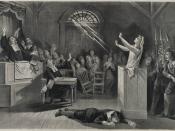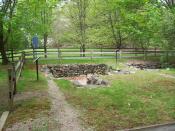The story of Salem Village has been cemented in American folklore since its origins in the latter seventeenth century. Dramatization of the events has brought about many misconceptions of the true events that took place but historians themselves have the ability, due to the conditions and good records of the village and its accounts, to piece together the true life of Salem Village. Thomas Hutchinson, in 1750, was in opposition to the accounts that were alleged in the village basing the accounts on the call for attention by young girls rather than acts of a 'witch-covenanting devil.' Historical record does supply evidence that this view could portray the reality of the situation, with numerous accounts of false pretenses by the cursed young women, but this portrayal does leave some things unexplained: eye witness testimonials, certain behaviors of the young women, and several other sobering behaviors alike. Further analysis of the psychological effects that such events would cause has led many historians, who dismiss the presence of witchery, in contrast with the view of these events as a game of fraud and lead them to a belief in abnormal psychology.
In taking this view historians have not only been able to describe the effects that this alleged cursory had on its victims but also the roots of what would cause certain villagers at the time to try their hand at said witch craft.
Social historical analysis of the events that took place in Salem provides insight outside of the microcosms described above providing reasons for why said individuals would choose to act in these ways. Initial speculations of existent correlations between church membership and wealth only left historians at a dead end. Social historians, Paul Boyer and Stephen Nissenbaum, took to analyzing the geographical context of the Salem trials in...


